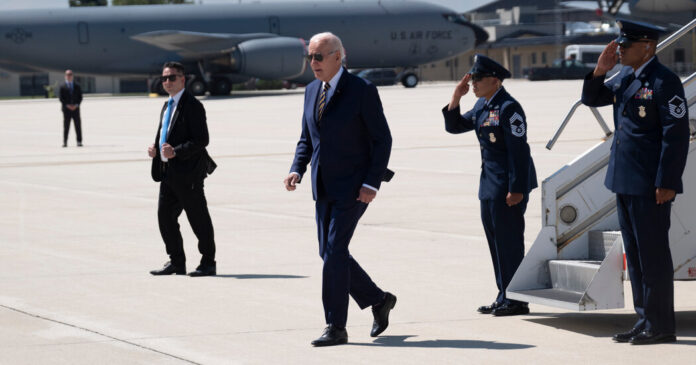President Biden said on Tuesday that he would travel to Hawaii to inspect damage on Maui after deadly wildfires ripped through the island, killing at least 99 people and devastating an entire coastal town.
“My wife, Jill, and I are going to travel to Hawaii as soon as we can,” Mr. Biden said in a speech focused on the economy at a wind and electric power manufacturing plant in Milwaukee. “That’s what I’ve been talking to the governor about but I don’t want to get in the way.”
Mr. Biden had not addressed the Maui wildfires since last week, when he declared a federal emergency and issued a statement with condolences for the families of those who died. His relative silence had drawn criticism from Republicans, which led to pushback from the White House.
Mr. Biden spoke with Gov. Josh Green of Hawaii and Deanne Criswell, the administrator of the Federal Emergency Management Agency, during his flight to Milwaukee, White House officials said.
The governor, a Democrat, thanked Mr. Biden on Tuesday for the federal government’s support in the Maui crisis.
“Mahalo for having our backs in this time of need with the full force of the federal government,” Mr. Green wrote on Facebook over a posting of the White House announcement.
Frustrated residents of West Maui have complained that victims were receiving less disaster aid from the government than from their own ad hoc volunteer network.
In recent days, however, hundreds of FEMA workers have been on the ground in Maui, including Ms. Criswell. The governor has also been in regular contact with the White House.
By Monday afternoon, more than 3,000 people had registered with FEMA for federal assistance, according to Jeremy Greenberg, the director of the agency’s operations division.
FEMA is typically the first agency to face intense scrutiny after disasters, but while it plays a critical role in disaster response, its mission is to support states with funding and other resources, not to be the first on the scene.
Maui is still reeling from the deadliest wildfire in the nation in more than a century.
Recovery teams with cadaver dogs are searching for bodies in the ruins of incinerated cars, houses, businesses and historic landmarks and painstakingly working to identify the dead and notify their families. Only about a quarter of the burn area has been searched, and the toll is expected to rise substantially.
The fire devastated much of the west side of the island, including Lahaina, a coastal community of 13,000 that was once the capital of the Hawaiian kingdom, and wiped out more than 2,000 structures, the vast majority of them residential.
Mr. Biden said in his remarks Tuesday that he wanted to ensure that his visit didn’t disrupt recovery efforts before ticking through the assistance the federal government has begun to provide, including supplies, one-time cash payments and additional personnel to help aid firefighters and relieve first responders.
The fire’s stunning toll — abetted by hurricane-driven winds and drought-parched grasslands — has raised questions about whether Hawaii’s management of electrical infrastructure should have been more aggressive. Although an official cause for the fire has yet to be determined, witnesses have posted photos of a downed power line in an area of Lahaina where the authorities reported a critical flare-up, and the fire has already prompted lawsuits against Maui’s dominant utility.
Lawyers for Lahaina residents suing Hawaiian Electric have contended that its equipment was inadequate to withstand the winds, and that the company should have shut down power during high-wind warnings. Hawaiian Electric officials have said that the company policy does not include power shut-offs during wildfires because the loss of electricity can create problems for first responders and people who use medical equipment that runs on electricity.
Criticism also has focused on state and local emergency management as the fires raged. Warning systems intended to alert residents to natural disasters failed to function and traffic management during the fire, as power poles toppled and panicked residents scrambled to outrun the inferno, drove hundreds of victims into gridlocked roads that became death traps.


